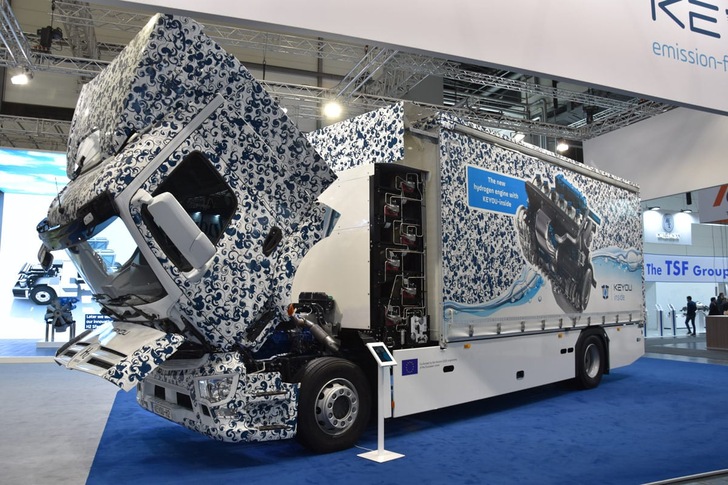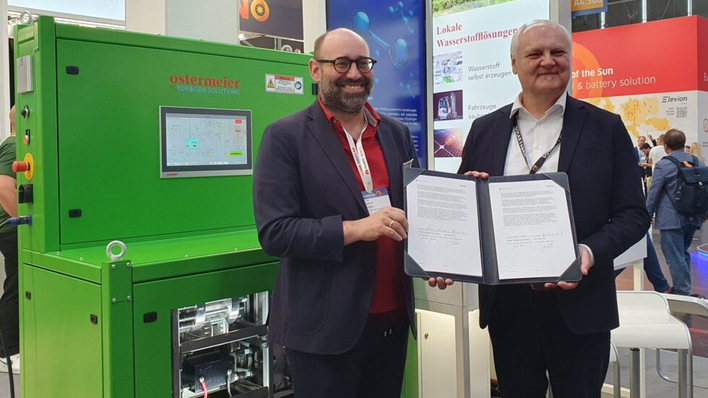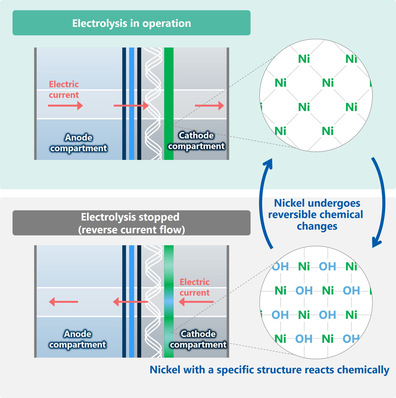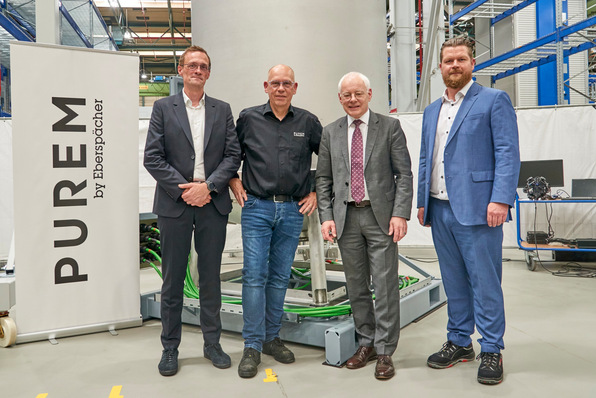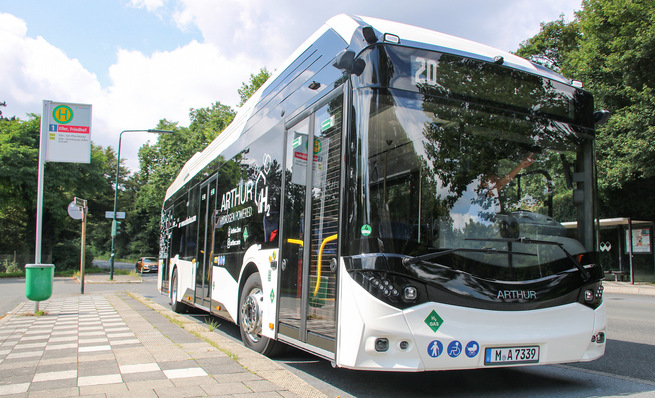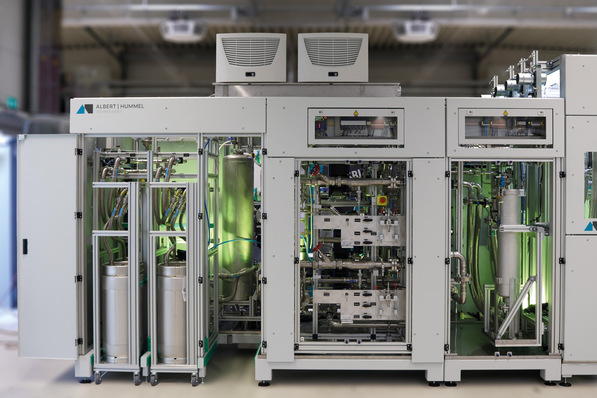Be it fuel cells or hydrogen engines, (almost) all major commercial vehicle manufacturers are putting their efforts into hydrogen propulsion. A fact that has so far largely gone unnoticed by the average person. While the public debate still rages around the use of hydrogen in the automobile industry, it would seem the trucking sector made up its mind long ago: There’s no future without hydrogen. This was proved beyond doubt at Germany’s IAA international motor show for commercial vehicles which ran from Sept. 20 to 25, 2022, in Hannover, even if about 90 percent of the vehicles exhibited still had diesel engines.
The trend toward electrification was abundantly clear in every corner of IAA Transportation. While the roughly 1,400 exhibitors still earn their crust from diesel vehicles, the electromobility theme lends itself perfectly to marketing campaigns. Many booths took the opportunity to play around with the concept – as was the case at the IAA car show several years ago. When questioned, however, it immediately becomes apparent that electric vehicles are little more than a glint in the eye for the commercial vehicle sector. Significant volumes are still some way off – not just because of a shortage of staff and electronic chips, but also due to regulatory or technical hurdles.
One exhibitor, for example, explained that trucks with hydrogen engines cannot be classified as zero-emission vehicles since the intake air ends up being measured alongside the exhaust during emissions testing, and this incoming air usually contains pollutants. Automotive supplier Mahle reports that popular electric engines often drop to 60 percent power output after one minute at maximum power. Unlike its own modules which can guarantee a continuous output of 92 percent (240 kilowatts).
An added issue is that fuel cell units experience cooling problems when, say, a 40-ton truck needs to travel over the Alps, therefore requiring a high level of power over a prolonged period. This is where hydrogen engines have the upper hand. On the downside, however, are the high temperatures that combustion entails as these create favorable conditions for the production of nitrogen oxides. While nitrogen oxide emissions can be significantly reduced using a catalytic converter, it doesn’t eliminate them completely – a contrast to a purely electric vehicle which has zero local emissions.
Comeback of the hydrogen ICE
The key topic of the moment for the hydrogen sector when it comes to commercial vehicles is the hydrogen internal combustion engine. Keyou, which currently employs 70 members of staff, has been working on it for years. Nothing new there. But now the likes of Cummins, Daimler, Iveco, MAN and even Unimog (to name but a few) are also busy exploring this area of technology. The question posed by Jürgen Nadler, chief marketing officer at Keyou, is telling: “Do you know anyone who’s not working on it?”
The reason for the hydrogen ICE’s dramatic comeback is said to be the “extremely high number of requests.” This has led Keyou to adjust its strategy. From now on the Bavarian technology company is focusing on the conversion of existing vehicles based on the Mercedes Actros. “We are moving away from OEM and toward end customers,” said Nadler. Initial trials with its hydrogen truck are planned from summer 2023, with the expectation that a small fleet of eight vehicles will be ready for testing by the end of the year. In 2024 the number of shipments could increase to as many as 50. By then the retrofit time should be around the three-week mark. Keyou’s engine of choice for its refitting work is a Deutz. Its ability to power buses was demonstrated by Keyou using a Solaris model, also on display in Hannover, which was converted by the Paul Group.
One of the large engine manufacturers involved in hydrogen ICEs is Cummins, despite the US corporation possessing extensive fuel cell expertise following its takeover of Hydrogenics. In Europe, where over 10,000 people are now employed by Cummins, the company is cooperating with a number of other businesses, including Scania. Cummins’ historical roots are in engine development, which is why Jennifer Rumsey, president and chief operating officer, backed up its strategy by saying: “Hydrogen engines are able to speed up the rollout of the hydrogen economy. There will be a market for them. There isn’t one single solution.”
Another competitor that is convinced combustion engines are the future is FPT Industrial. The Iveco Group subsidiary exhibited its XC13, a multifuel engine that can run on diesel, methane or hydrogen. The six-cylinder engine offers 600 horsepower and meets the fleet-wide carbon dioxide emissions target applicable from 2025.
Issues with vehicle length
The focus of an ongoing and controversial discussion is vehicle overlength – an issue which also brings into question how hydrogen tanks are installed. While some industry players claim they solved this challenge long ago, others are still searching out legal loopholes or regulatory assistance. The crux of the problem is that the installation of hydrogen vessels behind the cab makes the trucks 60 to 80 centimeters (24 to 31 inches) too long, meaning that all vehicles would require individual approval. Certainly not a practical option.
Nikola, for example, chose to circumvent this regulatory hurdle, aided by a special rule on fuel economy due to improved aerodynamics. Faun, meanwhile, integrates its hydrogen storage into the chassis.
In Hannover the new Faun subsidiary, Enginius, demonstrated its own solution in the form of a prototype of the new CityPower, which was presented to the public for the first time. This second model released by the Bremen-based company (following the BluePower – see H2-international, August 2022) uses an Atego from Daimler Trucks which features a 9-metric ton payload and a 500-kilometer (310-mile) range with 32 kilograms of hydrogen (at 700 bar). Initial field tests are due to begin at the end of 2023, with commercialization planned for 2024.
“The commercial vehicle sector is wonderfully unemotional – all that counts is the total costs of ownership (TCO).”
IAA exhibitor
Iveco and Nikola present Tre FCEV
Also not limiting itself to electromobility was the Iveco Group. As well as presenting the battery-powered Iveco Daily cargo van, the corporation unveiled its beta version of the European Nikola Tre fuel cell vehicle, which reportedly has a range of up to 800 kilometers (500 miles). The mass production of this long-haul semi-trailer truck for the North American market is provisionally planned to start at the end of 2023 in Coolidge, Arizona; for the European market it’s earmarked for the first half of 2024 in Ulm, Germany. That’s in spite of the announced shipment numbers having been repeatedly reduced.
President of Nikola Corporation Michael Lohscheller said: “This will be the beginning of a new era in clean commercial vehicles and innovative energy solutions for Europe.” Luca Sra, Truck Business Unit president of Iveco Group, added: “Today we are making history with the first products for the European market resulting from Iveco’s strong partnership with Nikola Corp. Our teams have co-developed a modular platform that is suitable for both fuel cell electric and battery electric powertrain technologies . It’s the world’s first electrically designed modular platform for heavy-duty tractor units that can run on both energy sources. A real revolution.”
Parallel to this, Iveco is also collaborating with Hyundai Motor Company. The Italian group joined forces with the South Korean corporation to exhibit a concept vehicle for a hydrogen-powered version of the Iveco eDAILY. The vehicle comes equipped with a battery pack from FPT Industrial offering 37 kilowatt-hours and 12 kilograms of 700-bar hydrogen as energy storage that allow it to cover 350 kilometers (215 miles) using the 90-kilowatt fuel cell power system from Hyundai, plus 50 kilometers (31 miles) in purely electric driving mode (electric engine: 140 kilowatts).
Daimler Truck presses on with LH2
At Daimler Truck, meanwhile, engineers are persevering with liquefied hydrogen (LH2) and the use of fuel cell stacks produced by cellcentric, which is now working on its gigafactory in Weilheim, Germany (2 x 150 kilowatts; see H2-international, August 2022). A refueling station for this cryogenic compressed gas is also in the offing. For the moment, the exhibited long-distance model of the GenH2 Truck remains just a prototype.
The liquefied hydrogen tanks in this case are built into the side of the chassis while the cooling unit along with the high-voltage battery (72 kilowatt-hours of installed capacity; 50 kilowatt-hours of usable capacity) is positioned behind the cab. When it comes to permissions, the GenH2 Truck doesn’t face any problems so long as certain conditions such as the journey range are met, H2-international was told.
Christian Mohrdieck, CEO of cellcentric, explained that the fuel cell systems produced in Weilheim would not just be supplied to its two joint venture partners Daimler Truck and Volvo Truck, but also to Rolls-Royce, which is using them in stationary solutions developed by its mtu brand. Thanks to these three customers, cellcentric has the backing it needs to scale up and thereby reduce unit costs.
Order of 5,000 hydrogen trucks has massive impact
Up until now, there have only been eight 350-bar refueling stations suitable for hydrogen buses or trucks out of a total of 95 hydrogen stations in Germany. Intent on changing this situation by intensifying their cooperation are two self-starters from the north of the country. To this end, Clean Logistics has sold 5,000 new hydrogen trucks to GP Joule Hydrogen which in return plans to build 150 hydrogen filling stations over five years. Both companies want to become joint “enablers,” sorting out both the infrastructure and the vehicles for potential customers, wherever they may be.
André Steinau, who heads up eFarming and GP Joule Hydrogen, said: “We are now witnessing the first trucks. Now the infrastructure for them needs to come too.” In conversation with H2-international he explained there are companies that make a living financing such projects. The role of GP Joule Hydrogen is to bring those that have the money together with the users, he said. Principally it’s about taking the eFarm concept, which has enjoyed great initial success in northern Germany, and rolling it out to the rest of the country, he continued.
Furthermore, he promised that hydrogen vehicles with a 700-bar tank will also be able to refuel at their stations, though the tank will only be two-thirds full, while the fuel will be around EUR 1.50 cheaper than at 700-bar stations.
Andreas Rimkus, the hydrogen representative from the SPD parliamentary group, had the following to say on the matter during watt_2.0 in Husum: “The announcement of 5,000 trucks made a real splash.” Together with Kurt-Christof von Knobelsdorff he affirmed that the idea is to enable hydrogen for the entire transportation industry since this is the sector with the greatest willingness to pay. Not that anything is likely to discourage hydrogen provision for this sector anyhow, it was said.
Quantron makes waves
When it comes to market rival Quantron, meanwhile, many industry players are still doubtful whether the spinoff from long-standing company Haller will actually be able to live up to the heady promises made over past months. Doubtless the company, based in the German city of Augsburg, has an excellent marketing department, as evidenced by the unveiling of multiple world premieres in Hannover.
Among them, a battery-powered Cizaris 12 EV city bus and the Daily QLI FCEV, which has subsequently been available to order. Showcased as Quantron’s crowning glory, however, was “The Monster” – which was confidently fanfared as the “Champion for Heavy Duty Transport.” The QHM FCEV (44 metric tons with 54 kilograms of hydrogen) supposedly achieves 600 to 700 kilometers (370 to 435 miles) on one fill-up whereas the Nordic version (60 metric tons with 116 kilograms of hydrogen) is claimed to reach up to 1,500 kilometers (930 miles). Support for the production of its hydrogen solutions comes from a band of well-known suppliers. The fuel cell stacks are sourced from Ballard, the power unit from Allison Transmission, the hydrogen tanks from NProxx and the refueling system from Neumann & Esser.
All this is tied up in the Quantron-as-a-service (QaaS) operating concept, which CEO Michael Perschke presented as a 360-degree ecosystem – a no-worry full-service package containing everything required, from the production of green hydrogen and appropriate infrastructure through financing and servicing schemes.
The first shipments of the “range champions,” as Perschke calls them, are expected to take place in mid-2023. To be able to serve customers from industry, logistics and food processing as well as the public sector, Quantron has ordered an initial batch of 140 latest-generation fuel cells for its heavy-duty trucks from its Canadian supplier.
With regard to the length and permit issue, Quantron stated: “We have our own solution. We have solved it.” The company guarantees “maximum range without restrictions on cab or trailer length.”
500 hydrogen trucks for the USA
Just three weeks after the IAA Transportation event, Quantron received a huge order: The Gersthofen-based truck manufacturer is set to supply 500 fuel cell trucks to American transport company TMP Logistics. The contract, which amounts to almost EUR 1 billion, covers the provision and maintenance of the vehicles as well as the fuel.
By contrast, Paul Nutzfahrzeuge openly admits that the company hasn’t finally resolved how to handle the overlength of its vehicles. To date, the prototypes have required individual approvals. Much more important to the special vehicle manufacturer was the presentation of its fuel cell truck which will be fitted with Toyota stacks as standard from now on. Also on show was Paul’s new modular and scalable PH2P hydrogen storage system, which was developed together with Anleg for original equipment manufacturers and conversion specialists.
In addition, Bernhard Wasner, director of the Paul Group, demonstrated the company’s new Transforming Trucking philosophy in which all activities will be organized henceforth under the umbrella of the Paul Group. He reported with visible pride: “We built the two Keyou prototypes that can be seen at the fair.”
Suppliers
Even heavyweight suppliers such as Bosch are now clearly putting hydrogen front and center. The head of Bosch’s supervisory board has announced the company’s ambition to have 40,000 fuel cell systems on the road by 2025. It is hoped that Bosch technology will not just be used in the trucks of customers such as Nikola but will also find their way into agricultural and construction machinery that will one day be powered by hydrogen engines. The group is also working with its subsidiary Bosch Rexroth on refueling station construction – together with compressor manufacturer Maximator Hydrogen. What’s more, in 2021, Bosch and Chinese vehicle manufacturer Qingling set up the joint venture Bosch Hydrogen Powertrain Systems.
Forvia, which describes itself as the seventh biggest automotive supplier in the world, exhibited a new cryogenic hydrogen storage solution for heavy-duty applications for the first time together with its two brands – Faurecia and Hella. This compact storage system, which was co-developed with Air Liquide, can transport the same quantity of hydrogen at a 40 percent reduced volume. Also on offer from Forvia were gaseous hydrogen systems, ranging from an 80-kilogram hydrogen storage solution to a 150-kilowatt fuel cell stack, which is provided by Symbio. In terms of light commercial vehicles, the French company is cooperating closely with Stellantis which, still in the form of the PSA Group, was a major shareholder in Forvia until 2021.
Canadian fuel cell manufacturer Loop Energy used the IAA as a springboard for its new S1200 module for the bus and truck market. According to President and CEO Ben Nyland, the unit is up to 60 percent fuel efficient. This comparatively high net efficiency level, which within the output range of 20 to 80 kilowatts only drops by 10 percent (peak power of 120 kilowatts), is made possible by eFlow technology – a mechanical process that allows media to flow more easily through the stack. This system has yet to appear on the market but, in Nyland’s words, Loop will “get more involved when the market grows.” The current plan is to roll out a test vehicle in the first half of 2023 and to start commercialization in the second half of the year. Initial orders have already been received following the trade fair.
Neumünster becomes hydrogen hub
Shortly before the IAA, companies Hypion and Resato Hydrogen Technology signed a contract stating their intention to build ten hydrogen filling stations in northern Germany. The collaboration is due to kick off with an automated public refueling station with 350- and 700-bar facilities for heavy-duty transport vehicles in the Neumünster Süd industrial park (capacity: 2,000 kilograms of hydrogen per day). The aim is to offer refueling to companies in the logistics, retail and construction industries at the Neumünster hydrogen hub from the second quarter of 2023. Seven hydrogen trucks are expected to be supplied by Clean Logistics (see box on p. 35).
Stefan Rehm, Hypion project lead, explained: “It’s only possible to achieve commercial viability with a totally different magnitude of sales in the order of several hundred kilograms of hydrogen a day. The project will ideally provide an appropriate boost for the launch of clean freight transport with green hydrogen onto the market.” Hypion is a joint venture between engineering consultancy IPP Projects, the Heide regional development agency, EDF Deutschland and HanseWerk.
Source: Hypion
Author: Sven Geitmann


